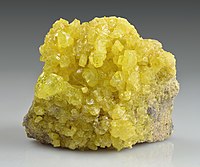
Photo from wikipedia
Abstract Elemental sulfur (ES) is a component essential for proper development of animals, but it can be toxic for aquatic organisms. The objectives of the study reported here included determination… Click to show full abstract
Abstract Elemental sulfur (ES) is a component essential for proper development of animals, but it can be toxic for aquatic organisms. The objectives of the study reported here included determination of ES concentrations in sediment collected in the area of the Gulf of Gdansk (Baltic Sea) and search for the possible correlations with the ecotoxicity results. Sediment samples were collected from four locations: the Vistula River mouth, in the Port Basin, in the area of discharge of the treated wastewater from the Wastewater Treatment Plant (WWTP) and in the area of the sunken World War II s/s ‘Stuttgart’ shipwreck. The levels of elemental sulfur were determined using a gas chromatograph coupled with a mass spectrometer (GC–MS). Toxicity of marine sediment samples was estimated for three biotest organisms – bioluminescent bacteria Vibrio fischeri , crustacean Heterocypris incongruens , and Synapis alba plant. The highest toxicity of sediments for all indicator organisms was observed in samples taken at the place of the shipwreck (2–100%). The same samples had a high sulfur content (16.7–143.2 µg/g dry weight (d.w.)) therefore, it was decided to investigate whether the presence of ES in the sediment in the studied area can have an impact on the results of the ecotoxicity determination in real samples. However, the removal of sulfur from the samples resulted in no significant changes in the level of toxicity of the samples. In this research it could not be confirmed that the presence of elemental sulfur is the only factor responsible for the observed sediment toxicity. It seems that other compounds or their mixtures present in the sediment may have a significant influence on the results obtained.
Journal Title: International Journal of Sediment Research
Year Published: 2017
Link to full text (if available)
Share on Social Media: Sign Up to like & get
recommendations!